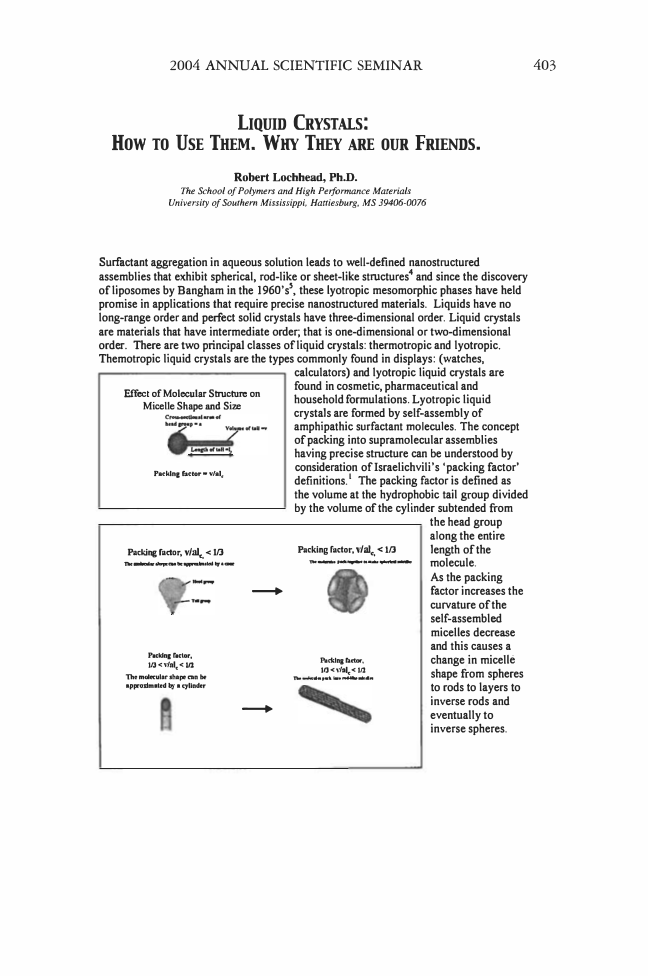2004 ANNUAL SCIENTIFIC SEMINAR LIQUID CRYSTALS: How TO USE THEM. WHY THEY ARE OUR FRIENDS. Robert Lochhead, Ph.D. The School of Polymers and High Pe,formance Materials University of Southern Mississippi, Hattiesburg, MS 39406-0076 Surfactant aggregation in aqueous solution leads to well-defined nanostructured assemblies that exhibit spherical, rod-like or sheet-like structures 4 and since the discovery of liposomes by Bangham in the 1960's S . these lyotropic mesomorphic phases have held promise in applications that require precise nanostructured materials. Liquids have no long-range order and perfect solid crystals have three-dimensional order. Liquid crystals are materials that have intermediate order that is one-dimensional or two-dimensional order. There are two principal classes of liquid crystals: thermotropic and lyotropic. Themotropic liquid crystals are the types commonly found in displays: (watches, Effect of Molecular Structure on Micelle Shape and Size Packln& factor• v/al, Packing fador, vi� . 1/3 . -..,.,,._ ... ___ , .... ..,,_ Packln1 ractor, IJJ,•fal.: l/l The molecular shape cnn be approximated by a cyllnder --+ --+ calculators) and lyotropic liquid crystals are found in cosmetic, pharmaceutical and household formulations. Lyotropic liquid crystals are formed by self-assembly of amphipathic surfactant molecules. The concept of packing into supramolecular assemblies having precise structure can be understood by consideration oflsraelichvili's 'packing factor' definitions. 1 The packing factor is defined as the volume at the hydrophobic tail group divided by the volume of the cylinder subtended from Packing factor, ,•/al e , 1/3 the head group along the entire length of the --•--• .. --- molecule . Pocklna lllctor, 1/J ,·tal c 1/l .-...:: ... , ................. .. As the packing factor increases the curvature of the self-assembled micelles decrease and this causes a change in micelle shape from spheres to rods to layers to inverse rods and eventually to inverse spheres. 403
404 JOURNAL OF COSMETIC SCIENCE At appropriate concentrations, the cylindrical micelles pack into hexagonal array to produce a liquid crystal phase that is a clear ringing gel. This gel formed the basis of brilliantine hairdressing. Increase in the packing factor to values greater than 0.5 causes the molecules to pack into planar arrays - this is lamellar liquid crystal. Lamellar liquid Lamellar Liquid Crystals P.1cking factor ,·/al e = 1 crystal is a lubricant due to the plane of slippage within the layers. The mutual repulsion between the layers confers a shear-thinning rheology with yield stress (Ellis rheology) on this phase. Lamellar liquid crystal is a useful stabilizing phase for oil-in -water emulsions and it has been used for this purpose to stabilize skin lotions against separation. In the liquid crystalline state, the hydrophobic tail groups of the emulsifier molecules display liquid-like mobility. If the temperature is lowered sufficiently, the hydrophobic chains crystallize and the lamellar phase undergoes a liquid crystal to gel transition. Stearate chains are usually gelled at room temperature. The lamellar gel phase displays more solid-like rheology than the lamellar liquid crystalline phase, but once sufficient shear is applied to overcome the yield stress it flows easily parallel to the slip plane. Lamellar gels are common stabilizing phases in cold creams. Lamellar phase also has the capability of binding water and lowering its evaporation rate and it is not a coincidence that 'lamellar' bodies are found between the corneocytes in the stratum corneum. Substances such as lecithin and distearyldimethylammonium chloride have Schematic cross section of a unilamcllar vesicle packing factors that favor lamellar phase. Slight curvature on the lamellae causes the layers to fold into spheres and form unilamellar or multilamellar vesicles. Such vesicles are useful as delivery vehicles. Hair conditioners are often formulated as multilamellar vesicles and this is achieved by self-assembly of twin-tailed surfactants or adjusting the packing factor of single tailed surfactants (e.g. acetyl trimethylammonium chloride) by the addition of cosurfactants such as cetyl alcohol. Reverse hexagonal lyotropic liquid crystal phase contains precisely juxtaposed aqueous cylinders embedded precisely in an organic matrix Cubic liquid c1ystalf There are two major classes of cubic liquid crystalline phase. Discontinuous cubic phases are intermediate between spherical micelles and hexagonal phase. Discontinuous cubic phase consists of spherical micelles packed in cubic array and it is exemplified by the Poloxamer gels that are used to thicken hydrogen peroxide. The packed micelle structure confers shear-thinning rheology and a rapid relaxation to the gel structure upon the cessation of shear. The second major c]ass of cubic phase is
Purchased for the exclusive use of nofirst nolast (unknown) From: SCC Media Library & Resource Center (library.scconline.org)






































































































